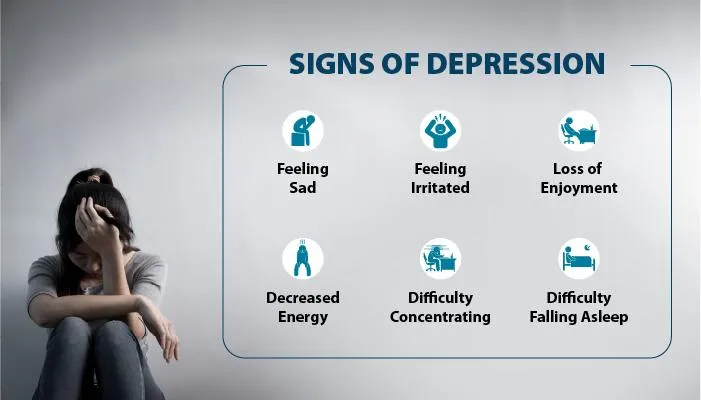
Are You Feeling Blue or Depressed? How to Tell the Difference and What to Do About It
Are You Feeling Blue or Depressed? When you’re feeling down, it’s easy to wonder: Am I just going through a rough patch, or is it something more serious like depression? The truth is, many people experience periods of sadness or low energy. However, it’s important to understand the key differences between temporary feelings of being “blue” and clinical depression. Knowing how to tell the difference can help you decide if it’s time to seek professional help.
In this blog, we’ll discuss the differences between feeling blue and depression, how to recognize the signs, and what steps you can take to improve your mental health.
What Does It Mean to Feel Blue?

Feeling “blue” is a common expression people use when they experience temporary sadness or low spirits. It’s a normal part of life to feel down from time to time, especially when facing challenges like relationship issues, work stress, or personal disappointments. Feeling blue may include:
- Mild sadness or melancholy
- Feeling less energetic or motivated
- Minor changes in sleep patterns (sleeping more or less)
- Temporary loss of interest in activities you usually enjoy
However, these feelings are typically short-lived. You might feel a bit low for a few days, but you still have hope that things will improve soon. Once the triggering event passes, such as a stressful period at work or a tough conversation with a friend, your mood generally improves.
It’s important to note that feeling blue doesn’t usually interfere with your ability to perform daily activities. You may still go to work, socialize, and engage in other responsibilities, even if you’re not feeling your best.
What Is Depression?

Depression, or major depressive disorder (MDD), is much more than just feeling sad or having an off day. It’s a serious mental health condition that requires treatment and can significantly impact all areas of life, including your relationships, work, and physical health. Clinical depression goes beyond temporary feelings of sadness, lasting for at least two weeks or more, and often involves a range of more severe symptoms.
Some common signs of depression include:
- Persistent feelings of sadness or hopelessness: Unlike temporary blues, depression often comes with feelings of emptiness and despair that seem endless.
- Loss of interest in activities: You may stop enjoying activities or hobbies you once loved, including spending time with loved ones.
- Fatigue and lack of energy: Even simple tasks like getting out of bed or showering may feel exhausting.
- Difficulty concentrating: Depression can cause cognitive disruptions, making it hard to focus, make decisions, or even think clearly.
- Sleep disturbances: People with depression may experience either insomnia (difficulty falling or staying asleep) or hypersomnia (excessive sleep).
- Changes in appetite: Significant weight loss or gain may occur, either due to lack of appetite or eating excessively.
- Physical symptoms: Depression can manifest physically, causing aches, pains, or digestive issues with no clear medical explanation.
- Thoughts of death or suicide: This is a severe symptom of depression, and anyone experiencing suicidal thoughts should seek help immediately.
How to Tell the Difference: Blue vs. Depression
The main distinction between feeling blue and depression lies in the duration, severity, and impact on daily life. Here’s a breakdown of the key differences:
| Aspect | Feeling Blue | Depression |
| Duration | Temporary, often lasting a few days | Lasts for two weeks or more |
| Energy Levels | Slight fatigue or low energy | Extreme fatigue, even with rest |
| Sleep Patterns | Minor sleep changes (slightly more or less sleep) | Insomnia or hypersomnia |
| Interest in Activities | Can still enjoy things but with less enthusiasm | Loss of interest in almost everything |
| Impact on Daily Life | May still be able to perform regular activities | Significant impairment in daily functioning |
| Physical Symptoms | None or minimal physical symptoms | Aches, pains, headaches, or digestive issues |
| Thoughts | Generally hopeful or neutral | Frequent negative or hopeless thoughts |
What You Can Do About It
Whether you’re simply feeling blue or suspect you might be experiencing depression, there are several steps you can take to improve your mental health.
1. Practice Self-Care
Regardless of whether you’re feeling blue or battling depression, self-care is essential for your mental well-being. Here are some key self-care tips:
- Get enough sleep: Prioritize 7-9 hours of sleep each night. Poor sleep can contribute to feelings of depression and exacerbate low mood.
- Exercise regularly: Physical activity is proven to improve mood by releasing endorphins and serotonin, which help combat feelings of sadness and anxiety.
- Eat a balanced diet: A nutritious diet rich in vitamins and minerals can have a significant impact on your mental health. Avoid excessive sugar or caffeine, as these can worsen mood swings.
- Engage in activities you enjoy: Even when you don’t feel like it, try to engage in hobbies or activities that once brought you joy. This can help break the cycle of negative thinking.
2. Reach Out for Support
Talking to a trusted friend or family member about how you’re feeling can help alleviate some of the emotional burden. Having a support system is crucial for managing mental health. If you suspect you are dealing with depression, it’s important to reach out to a healthcare provider.
3. Seek Professional Help
If your symptoms persist for more than two weeks and begin affecting your daily life, it’s time to talk to a doctor or mental health professional. A therapist or counselor can provide talk therapy (such as cognitive-behavioral therapy, or CBT), which has been shown to be highly effective for treating depression.
In some cases, a healthcare provider may also recommend medication, such as antidepressants, to help balance chemicals in the brain that regulate mood.
4. Try Mindfulness and Meditation
Mindfulness practices, such as meditation, deep breathing, or yoga, can be powerful tools in reducing symptoms of both temporary sadness and depression. Studies show that mindfulness can help increase self-awareness and emotional regulation, improving overall mood.
5. Monitor Your Thoughts
If you’re feeling blue, practicing positive self-talk and challenging negative thoughts can help improve your mindset. If you’re experiencing depression, working with a therapist to address these thoughts is crucial to your recovery.
6. Engage in Social Activities
Isolation can worsen feelings of depression, so try to engage with friends or family members, even if you don’t feel like socializing. Participating in social activities can improve your mood and provide much-needed connection.
When to Seek Help: Red Flags for Depression
If you experience any of the following symptoms, it’s critical to seek help from a healthcare provider immediately:
- Persistent feelings of hopelessness or worthlessness
- Inability to carry out daily activities or responsibilities
- Significant changes in appetite or sleep patterns
- Thoughts of self-harm or suicide
Depression is a medical condition, not a weakness, and it is highly treatable with the right support.
Conclusion
While it’s normal to feel blue from time to time, it’s important to recognize when those feelings may signal something more serious, like depression. If your sadness lingers for weeks and starts affecting your ability to function, don’t hesitate to reach out for professional help. With the right support and self-care practices, you can take steps toward healing and improving your mental health.
Remember: You are not alone in your struggles, and support is available. Whether it’s reaching out to loved ones, practicing self-care, or seeking professional treatment, there are options to help you feel better.
